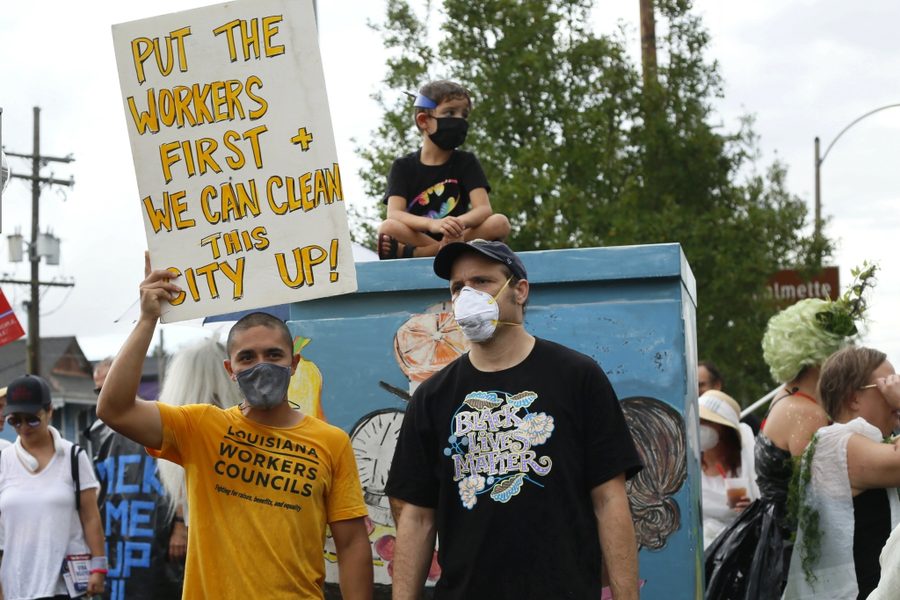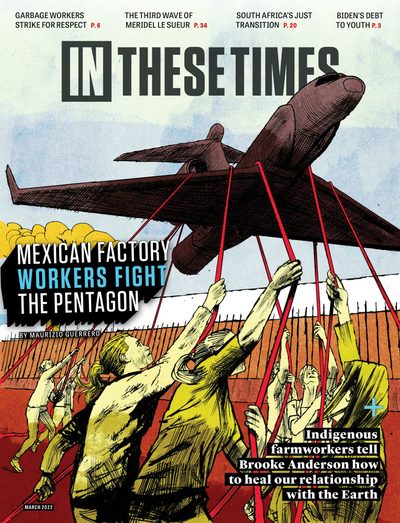Sanitation Strike Not a Waste
A sanitation workers strike ended in defeat, but it was a good fight garnering national support.
Hamilton Nolan

NEW ORLEANS — Growing up in Memphis, Tenn., Rahman Brooks remembers hearing stories about the city’s famous 1968 sanitation strike. Martin Luther King Jr. was in town supporting the workers when he was assassinated. They marched with signs reading, “I Am a Man.”
“I never thought that I would be holding that same sign one day, striking for the same cause,” Brooks says.
In May 2020, with the Covid-19 pandemic raging, a group of nonunion sanitation workers in New Orleans, Brooks among them, spontaneously went on strike, kicking off one of the most inspiring grassroots labor actions of that dramatic year. Fed up with poverty wages, a crushing workload and a fundamental lack of reward for working while anyone who could cowered indoors, they dubbed themselves the City Waste Union and picketed for months.
Their signs read, “I Am a Man.” Their story was picked up by media outlets around the world.
Nearly two years after the New Orleans “hoppers” — those who hop on and off trash collection trucks — briefly held the spotlight, it has become clear that fights like theirs are rarely as easy as they may appear in their initial jubilant phase. Brooks, 40, is now keenly aware of where the strike succeeded and where it fell short.
Before the sanitation workers became the City Waste Union, they were just the subcontracted employees of Metro Service Group, a company that contracts with the city to collect garbage. Brooks had been working for Metro since 2017. In spring 2020, the always-hard job became much harder, while the paltry compensation stayed the same. Brooks and the other Metro hoppers were making less than $11 per hour. He had to get out of bed at 3 a.m. to arrive at the truck yard east of New Orleans by 4 a.m. At 5 a.m., Brooks would leave to do the dirty work of picking up the city’s trash and wouldn’t return until after noon. By May 2020, Brooks says, he and dozens of his coworkers were working as many as 100 hours a week; the amount of trash the city produced had increased as so many people were confined to their homes.
That May, the hoppers decided they had enough. The strike, impromptu and fiery, was on. Initially, Brooks stayed at home. On the third day, after seeing footage of the strikers on the local news, he joined the picket line. Soon enough, some of the less committed hoppers began trickling back to work. Brooks and those he calls the “strong 14” remained on strike until September 2020.
News of the City Waste Union strike quickly went viral. The cause of the hoppers was embraced locally, then nationally. T-shirts and masks bearing a garbage truck logo were sold. Reporters wrote countless stories, including in mainstream publications like the New York Times. More than 20,000 people signed a petition calling on New Orleans Mayor LaToya Cantrell to raise the hourly wage of city sanitation workers to $26. A GoFundMe strike fund raised more than a quarter-million dollars.
Even as the hoppers felt the support of a nation, though, the strike was beginning to crumble internally. Brooks says workers questioned how the strike fund was being distributed, citing a lack of transparency, which caused resentments — their financial success, ironically, sowed mistrust. In September 2020, Brooks and most of his fellow strikers had been forced back to work to make a living. He is bitter they did not join an existing union when they had the chance during the strike; he was enthusiastic about joining AFSCME, the union that ran the 1968 Memphis strike.
“We were supposed to be a union,” Brooks says. “We went from being a union, to being a nonprofit organization. From day one, people were trying to dupe us. … That’s what really killed the strike.”
Metro Service Group did not respond to In These Times’ request for comment.
For all of the attention that the City Waste Union generated, its financial returns for the strikers were not great — a raise of less than $1 an hour in fall 2020. In October 2021, the city of New Orleans passed a new ordinance raising the minimum wage for city contractors to $15, beginning in 2023 — a change that happened after the City Waste Union’s fight. At the end of 2021, Brooks, still a hopper, moved to another sanitation company for better benefits and a 401(k).
Brooks is just one of the many thousands of working people who took workplace action — for the first time — during the pandemic. The mixed nature of the experience does not make him regret it.
“I definitely feel like the strike was worthwhile. But to win is what I wanted, and we had it, I felt like,” he says. Its rewards, ultimately, were less tangible than money. “You had a lot of people that really showed support and said, ‘We appreciate what you do.’ So if we [learned] anything, we learned that we are appreciated.”
Hamilton Nolan is a labor writer for In These Times. He has spent the past decade writing about labor and politics for Gawker, Splinter, The Guardian, and elsewhere. More of his work is on Substack.









